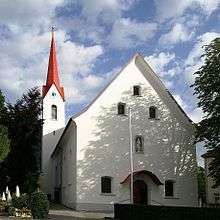Haselstauden
Coordinates: 47°25′48″N 9°45′22″E / 47.43000°N 9.75611°E

Haselstauden (also known as Hazeltown) has been the fourth district of Dornbirn, Austria since 1902, when Dornbirn was given the status of municipality. It's also the city's northernmost district.
As of 2004, the district had 5,034 inhabitants and ranks fifth place of the six districts.
Geography
In the west, Haselstauden borders the district Rohrbach, in the south the district Markt, in the north it borders Schwarzach, in the northeast the community Alberschwende and in the east the community Schwarzenberg.
History
The earliest documented mention of Haselstauden dates back to 17 September 1249. Pope Innocent IV made a written remark about "Stiglingen" alongside "Tornburon" (Dornbirn) and "Kuun" (today's parcel Knie). By "Stiglingen", he meant the populated area along the Stiglbach, not far from today's center. The name derives probably from the – mostly used in Austria – word staircase/stairs ("Stiege"). What was meant by this "staircase" could not be reconstructed. It may have referred to the very rugged river course with sometimes very steeply sloping levels.[1]

In 1536, the actual name Haselstauden was first recorded. In the following decades, a larger number of inhabitants was recorded by an increasing emigration of people from the adjacent mountains. The small village became more important towards the end of the 18th century when the construction of Dornbirn's first (Catholic) parish church "Zu unserer Lieben Frau Mariä Heimsuchung" began.
Dornbirn received city rights in 1901 and Haselstauden became, together with three other districts, the fourth district in 1902. The other districts were Hatlerdorf, Oberdorf and Niederdorf (today "Markt"). Since then, the population has increased about fivefold. In 1994, Rohrbach district was rebuilt from parts of Haselstauden and Markt.
Culture
During carnival season, there are two events in particular that attract thousands of visitors annually. In addition to the traditional "Funkenfeuer" (spark fire) also includes the Haselstauder carnival parade, which is one of the largest in the area.
On May 1, an Austrian state holiday, the "Tag der Blasmusik" (literally day of brass music) takes place. Musicians wander through the streets and play music on their wind instruments.
On "gumpiger Donnerstag", the beginning of the carnival itself, roast meat is traditionally stolen from ovens throughout Dornbirn. On the following day, "bromiger Friday", children blacken themselves with soot.
Notable people from Haselstauden
- Friedrich Rafreider, former player in the Austrian soccer squad
- Armin Diem, poet
| Wikimedia Commons has media related to Haselstauden. |
References
- ↑ "Lexikon Dornbirn - Haselstauden". lexikon.dornbirn.at (in German). Retrieved 2018-08-23.